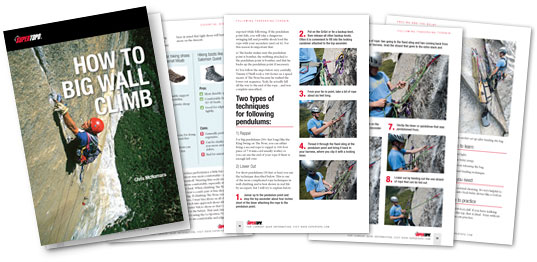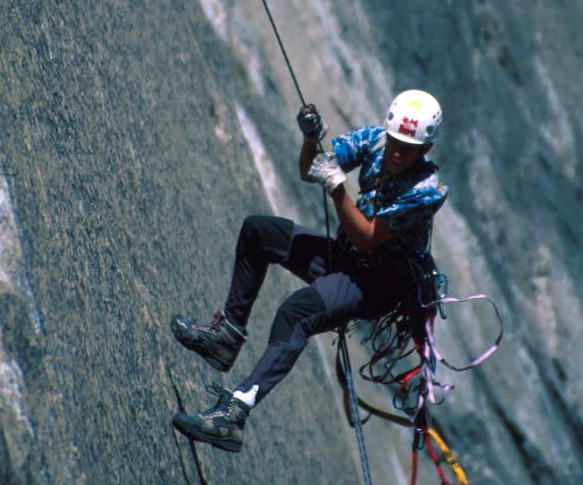This is part of the How to Big Wall Climb SuperTopo book. Videos like the ones above illustrate key points of the book and are meant to be watched while reading the book. Buy the book here or just read this free sample of the text below with photos.

Visit on supertopo.com
How To Big Wall Climb - Following 4: Traversing Terrain
This is part of my How To Big Wall Climb project. View the table of contents here.
You can read about basic aid gear here.
A Note About Links
The links go to our Price Finder where you can see if we have a review for that gear and then search for the best price. If you then buy something from that online retailer after clicking on one of those links, we get a little piece of the sale. If you are thinking about buying some of the gear mentioned in this article, we would appreciate it if you would click on one of the links before you buy. It won’t cost you anything extra, and it does help support this website. Thanks for keeping us in mind. Our affiliates are Altrec, EMS, Moosejaw, Mountain Gear, Mammoth Gear, Backcountry, Patagonia, and REI.
Chris Mac Pick
I add (Chris Mac Pick) after any gear that is currently my favorite. Click here to see what is currently on my El Capitan rack.
Gear Reviews
You can see all our big wall gear reviews here
Intro
Cleaning traversing terrain is not fun. It can take a long time and is sometimes more dangerous than leading for three reasons:
For these reasons it is very important to get your skills dialed when cleaning traversing terrain.
Skills to learn
Gear you need
Same as normal cleaning. Its very helpful to have an auto-lock belay device like a GriGri
When to practice
For just learning the basics of lower-out, you just need any anchor point.
For following a horizontal traverse, you can practice on a rafter that is at least 10 feet long and you can sling.
With the basics worked out, you will want a cliff that has a crack or bolt line that traverses at a 30-45 degree angle. Prefereably the cliff with be 30-50 feet at, you guessed it, 80 degrees (a little slabby).
Be carefull when choosing a place to follow pendulums. If you are low to the ground, and you mess up, there is a good chance you will hit the ground. Get the basics dialed before you actually practice following a pendulum on a cliff.
Cleaning Traverses
There are two techniques used for two types of traverses: diagonal traverses and horizontal traverses. IMPORTANT: Both techniques share one thing in common, its important to back yourself up with back-up knots or a GriGri. Almost all cases of people coming detached from their jumars happen on traverses because the rope can run through the Ascender at a weird angle that causes it to twist out.
A. Cleaning Diagonal Traverses: [need some images here but not sure how many] When the rope is running to the side at an angle of 30-70 degrees, it is tricky to clean pieces because after passing the Ascender over the piece and weighting it, you are pulled to the side. Sometimes you can just paste your feet against the wall, lean over for a moment and quickly remove the piece (sticky rubber approach shoes help a lot). However, if the terrain is too steep, sometimes you need to pass both jumars over the piece, go up another foot or two, then reach down and or swing back over.
B. Cleaning Horizontal Traverses: When you are cleaning a roof or horizontal crack, its best to re-aid the pitch for two reasons:
- speed – cleaning horizontally on Ascenders is very awkward and can get you in some clusters that take a while to get out of
When re-aiding, I use a GriGri to self belay. You can also tie back up knots but you will want to tie them very often to feel safe. Even then, a GriGri will still feel better because you can easily keep yourself on a tight belay.
The basic re-aiding technique goes like this
1) jumar up to the last piece before the traverse
2) put on the GriGri or tie a back up knot
3) standing only on the bottom jumar, unclip the Aider and daisy from the top Ascender and clip in directly to the piece.
4) remove the top Ascender and clip it to the side of your harness or let it hang
5) stand in the Aider attached to the piece
6) unclip the piece from the rope and clean it
7) remove the bottom Ascender from the rope and clip the Aider and daisy to the next piece.
8) you are now re-aiding until you reach the end of the traverse and can start jumaring again
Pendulums
On a pendulum, you are at your most exposed while following. If the pendulum point fails, you will take a dangerous swinging fall and possibly shockload the rope with your Ascenders (and cut it). For this reason its important that:
a) the leader makes sure the pendulum point is bomber, the webbing attached to the pendulum point is bomber, and that he backs up the pedulumn point if necessary.
b) you follow the steps below very carefully. (maybe insert Timmy O story hear)
There are two types of techniques for following pendulums:
1) For big pendulums (30+ feet long) like the King Swing on The Nose, you can either bring a second rope to rappel (a 100-foot piece of 7-8 mm cord usually works) or you can use the end of your rope if there is enough left over.
2) For short pendulums (30 feet or less) you use the technique described below. This is one of the more complicated rope techniques in wall climbing and is best shown in real life by an expert, but I will try to explain below:
1) jumar up to the pendulum point and stop about 6 inches short.
2) put on the GriGri or tie a back up knot then release all other back up knots
3) from your tie in point, take a bit of rope about 6 feet long.
4) thread it through the fixed sling at the pendulum point and bring it back to your harness where you clip it with a locking biner.
5) there are now for strands of rope: two going to the fixed sling and two coming back from the sling and clipped to your harness. Grab the strand that goes to the extra slack and winch yourself tight.
6) all your weight should now be on the pendulum point
7) unclip the biner that was pendulumed from
8) lower out
9) when at the end of the lower out, unclip the locking biner at your harness and let all the rope back out
Bonus: The third way to Clean a Pendulum
In rare cases, you can clean a pendulum by redoing the pendulm. To do this, the leader must have set up an anchor immediately after he did the pendulum. This almost never happens because usually the leader does a pendulum and then climbs up 10 or 20 feet before placing a piece (and thereby reducing the rope drag for him to finish the pitch).
But occassionally it works. A popular instance is if you are doing The Nose in a day. If the leader stops at Eagle Ledge after The King Swing and anchors the rope he just swung on. The follower can then rappel down the other side of the rope (on a single strand) and redo The King Swing. Once the follower completes the pendulum and is anchored on Eagle Ledge, he can untie from one end of the rope and pull it through the anchor on top of The Boot Flake. (On the King Swing this strategy does NOT make sense if you have have haul bags. Its only an option for Nose in A Day climber who both want to do the King Swing.)
WATCH A VIDEO ON LOWER OUT
Erik Sloan made a great movie on lowering out. The technique in his movie is a little different than what I describe above, but it equally effective if not better.
Watch the YouTube movie - http://www.youtube.com/watch?v=zPM5md01P_Y
WATCH A PHOTO DIAGRAM ON LOWERING OUT FROM THE KING SWING ON THE NOSE
http://www.supertopo.com/climbing/thread.html?topic_id=714500
See what is currently on Chris McNamara's El Capitan rack.
Read the rest of this chapter in the How to Big Wall Climb SuperTopo book

Visit on supertopo.com
